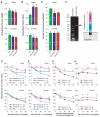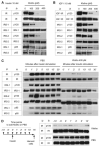Suppression of aging in mice by the hormone Klotho
- PMID: 16123266
- PMCID: PMC2536606
- DOI: 10.1126/science.1112766
Suppression of aging in mice by the hormone Klotho
Abstract
A defect in Klotho gene expression in mice accelerates the degeneration of multiple age-sensitive traits. Here, we show that overexpression of Klotho in mice extends life span. Klotho protein functions as a circulating hormone that binds to a cell-surface receptor and represses intracellular signals of insulin and insulin-like growth factor 1 (IGF1), an evolutionarily conserved mechanism for extending life span. Alleviation of aging-like phenotypes in Klotho-deficient mice was observed by perturbing insulin and IGF1 signaling, suggesting that Klotho-mediated inhibition of insulin and IGF1 signaling contributes to its anti-aging properties. Klotho protein may function as an anti-aging hormone in mammals.
Figures




References
Publication types
MeSH terms
Substances
Grants and funding
LinkOut - more resources
Full Text Sources
Other Literature Sources
Medical
Molecular Biology Databases
Miscellaneous

